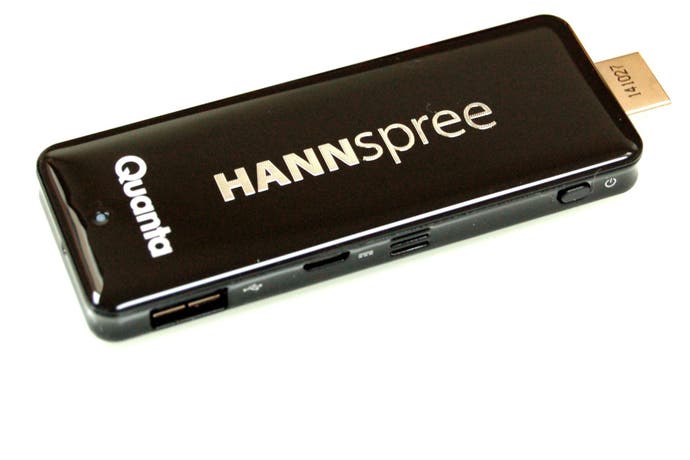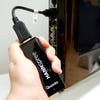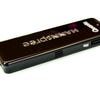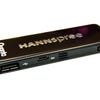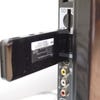Windows on a stick: the Hannspree Micro PC review
A quad-core PC in the palm of your hand.
It's the giveaway of a lifetime. Microsoft is handing over free copies of its Windows 8.1 operating system - with gratis upgrades to Windows 10, no less - while Intel is heavily subsidising its Atom range of processors in order to shift them in bulk. Lacking momentum compared to Android and iOS, Wintel wants its products to become a staple component of your mobile life, and they're willing to pay for the privilege. We've already examined the sub-£100/$120 Windows tablet phenomenon, zeroing in on the remarkable Linx 8 tablet, but Wintel's generosity has kickstarted a new wave of fascinating miniature x86 devices, kicking off with the Hannspree Micro PC.
This is just the beginning - many more variations on the theme are set to arrive imminently. Indeed, Intel itself has its own Compute Stick, unveiled last month at CES. The concept is identical to the Micro PC - it's a complete computer you can hold in the palm of your hand, a small black stick of x86 fun that inserts directly into an HDMI monitor or HDTV. Once a micro USB power supply is attached, what you get is the most comprehensively flexible Smart TV extender on the market, running the full Windows 8.1 operating system - and with it access to the most advanced media playback apps available, the Windows Store, and of course, decades' worth of legacy apps, including your Steam library.
Specs for the Micro PC will be very familiar to those who read our recent Linx 8 review - we're looking at a quad-core 1.83GHz Intel Atom CPU, paired up with a GPU component that's almost literally a quarter-sized version of the Intel integrated graphics tech in the Core 'Ivy Bridge' processor. That's paired up with 2GB of low-voltage DDR3, and 32GB of Samsung eMMC NAND, without around 24GB left for the user to do with as they will. There are differences with the Linx 8 spec though, specifically the use of the Z3735F Atom chip, which has around half the bandwidth of the otherwise identical Z3735G in the tablet (the 'F' variant is used in most of the 7-inch Windows slates though).
Port selection is reasonable - on top of the jutting HDMI connection, you'll find a full-size USB 2.0 socket, and micro USB for power, along with a micro SD slot on the other side for expanded storage (we tried out the 64GB card here from our Linx 8 and that worked just fine). That's enough to work with, but a second USB port would have made a huge difference - and it's not as if there isn't room on the casing. Rounding off the feature list here is the obligatory power button. It's nice to have it, especially as it's a feature that that often gets forgotten on 'plug in and forget' mobile devices. Also included in the box is a male to female HDMI extender, allowing you to more easily tuck the Micro PC away behind your display.
- Order the Hannspree Micro PC from Amazon with free shipping.
Powering up the device, the OS boots in 17 seconds, pretty much on par with the Linx tablet, giving you access to Microsoft's modern interface, where the traditional Windows desktop is just one click away. But making that click introduces a certain element of challenge, when only one USB port is available. The Micro PC does have Bluetooth functionality, so keyboards, mice, remotes and even PlayStation Dual Shock joypads can hook up to the device easily enough. But to begin with, you'll need to set everything up with just the single USB port - thankfully we had a Logitech wireless keyboard/mouse receiver dongle we could use, but be prepared with your own kit should you decide to invest in one of these miniscule computers.
From there, you're free to chart your own course through the Windows domain. We downloaded our go-to Windows Store game, Hydro Thunder Hurricane, a title that worked pretty well on our Linx 8 tablet. Frame-rates suffered on the Micro PC, as we were playing at 1080p vs the 1280x800 native resolution of the Linx, but it was still fairly playable. Dipping into Steam, we found an equivalent experience playing Half-Life 2 and Doom 3 BFG Edition, both capable of 720p30 gameplay - though dips beneath occurred when transparency effects were in play.
Curiously, navigation through Windows - particularly in the desktop mode - felt a little slower than the Linx 8, despite the stick featuring twice the memory of the tablet. Running our standard mobile benchmarks threw up some interesting results - while the GPU part of the Bay Trail SoC offered up nigh-on identical performance to the Linx 8 tablet, the CPU took a hit. Presumably that's down to the lower bandwidth, something that will affect the cheaper Windows tablets based on the same Z3735F processor. We've tossed in some Bay Trail benchmarks from the Asus T100TA Transformer Book, a more expensive two-in-one laptop/tablet hybrid device. This shows that higher-end Atom based CPUs do command a speed advantage - perhaps down to the dual-channel RAM. Both of the Z3735 Bay Trail chips are single-channel only.
| Hannspree Micro PC | Linx 8 Tablet | Asus T100TA two-in-one | |
|---|---|---|---|
| Geekbench Single-Core | 616 | 791 | 711 |
| Geekbench Multi-Core | 1878 | 2196 | 2461 |
| 3DMark Graphics | 14697 | 14696 | 16449 |
| 3DMark Physics | 12299 | 14607 | 15985 |
| 3DMark IceStorm Unlimited | 14086 | 14676 | 16343 |
| GFXBench T-Rex | 15.9FPS | 16.0FPS | 16.0FPS |
While the drop down from our tablet performance is a little disappointing, the Micro PC should serve as a better desktop PC overall, owing to the 2GB of onboard RAM vs the 1GB found in the cheaper Windows tablets. And it's certainly a significant leap beyond the single-core first-gen Atoms found in the old Netbooks, where the 'classic' N270 processor commanded a mere 403/565 Geekbench 3 score. Mostly shipping with Windows XP, those old Netbooks still manage to run Windows 8, so it's no surprise to find the immensely improved current-gen Atoms do sterling work with Microsoft's latest OS.
But as cool as a tiny handheld PC is, it's gameplay we're mostly interested in, and in this respect, it's fair to say that there weren't quite enough 'wins' to make this a worthwhile product, even for light Steam gaming. You'll find plenty of tips and settings tweaks online for running reasonably modern titles on entry-level Bay Trail hardware, but in truth, it's usually more hassle than its worth. However, this particular chipset comes with a rather decent h.264 video decoder and while it's useful for HTPC use, it makes the Micro PC a great contender as a client for Steam's in-home streaming.
In-home streaming is pretty much the best remote play solution around right now, allowing you to beam over gameplay from a dedicated games PC located elsewhere in the home. However, there are some problems getting everything set-up on the Micro PC. Curiously, Steam's Big Picture mode - the TV-friendly interface - requires a lot of GPU power, with the software suggesting a downscale to run smoothly on the Bay Trail's integrated graphics. However, it doesn't look bad, and once you've chosen the game you want to stream, full HD graphics return. Depending on the settings chosen, and the capabilities of your host PC, there's no reason why you can't enjoy full 1080p60 gameplay via your Micro PC - the device's onboard video decoder is certainly up to the challenge.
In-home streaming offers resolution, frame-rate and image quality that outstrips Sony's remote play in virtually every regard, but similar to the PlayStation technology, there are certain best practices to get a good experience - having your PC linked to the router via a wired LAN connection is key to this, as is the use of a joypad (mouse control highlights latency, while pad gameplay disguises it to an often startling degree). However, the results are generally worth it. In-home streaming is a key component of Valve's Steam Machines initiative. The firm aims to take PC gaming out of the bedroom/office/den and beaming gameplay around the home is a key component in this, with bespoke streaming client hardware coming at some point. Bearing in mind that the Steam Machines are designed to supplant the PC's reliance on Windows, there is perhaps some irony in the idea that it's a Wintel device that offers such a good 'Stream Machine' experience.
Beyond that, there is the sense that the Micro PC's appeal is more about its diminutive form factor than it is about its actual functionality and usefulness. At its £130-£170 price-point, its all-in-one nature challenges the Bay Trail-powered Intel NUCs and Gigabyte Brixes on the market, but it lacks the expansion capabilities (or the IR remote receiver) to deliver the knockout blow to those more expensive devices.
Of course, the elephant in the room is the presence of the entry-level Windows tablets like the HP Stream 7 and the Linx offerings. Based on the same Intel architecture, they're actually cheaper than the Micro PC, and of course you get the benefits of a fully mobile, battery-powered PC with a touch-screen (with HDMI output included). The Micro PC has the benefit of 2GB of RAM of course, but then, so does the larger Linx 10 tablet, often on sale at the same price-point. The tablets also feature a year of Office 365, which includes 1TB of OneDrive cloud access (shortly upgrading to unlimited storage), plus 60 free Skype minutes per month. This is not included with Micro PC.

Given time, the chances are high that there will be some movement on the price. Produced by Taiwan's Quanta Computing, the Micro PC is currently somewhat unique in terms of its form factor, but the Far East is already gearing up to produce a range of very similar products, all based on Intel's Bay Trail technology, each of them running the freebie Windows 8.1 with Bing OS. Pre-orders are already available for slightly larger devices, with more connectivity options (such as a LAN port) or other distinct features.
Regardless, in the here and now, the Micro PC remains a fascinating device, effectively taking the form of a ten-year-old desktop gaming PC massively condensed into a passively cooled stick that easily fits into the palm of your hand. Its gaming credentials may be limited, but its usefulness is defined by its form factor along with its access to the vast range of x86 software out there. Doubtless there are countless, niche use-case scenarios out there where the Micro PC may find favour - for example, we quite fancy setting up a device like this with the Plex media player, dynamically adjusting HDMI refresh rates to match video frame-rates, producing flawless, stutter-free playback. Right now, that's something only a PC can do.
Doubtless there are many more individual use-case scenarios where this device will find appeal, but for now, the Micro PC is an undoubtedly cool little device rich with potential, and a great piece of client hardware for Steam's impressive in-home streaming technology.
